|
Catalog Appearances
|
February, 1903
 |
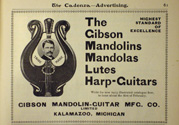 |
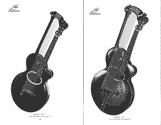 |
| Gibson's debut catalog |
Above is Gibson's first ad in
The Cadenza, January,
1903, which announces the first catalog that will be available
"about the first of February."
|
Four 1903 models are discussed, but
only two are shown: R (orange top, ivoroid binding), R-1
(pictured; black top, rope binding), U (pictured; black top,
rope binding), and the incredible U-1 (full extravagant
ornamentation).
The R was originally 17-⅞”
wide, with a 25-½"
scale and a large soundhole.
The U was 21" wide with a 27-¼" scale and large
soundhole.
|
|
|
The "Mystery Years" |
|
Catalog "B"?
January, 1904?
Under Cadenza's "Trade News" in both
the January and February, 1904 issues, they imply that there is a new Gibson catalog.
Jan: "Their new and complete catalogue is
illustrated with fine art half-tones..."
Feb: "...their new catalogue...is a work of art and
well worth possessing."
Presumably, this was intended to be ready for Gibson's participation
in the 1904 St. Louis World's Fair (April 30 - December 1).
Unless the "Red Brochure" (next) is really "catalog
B," this would be a key Holy Grail missing link document! |
The Red
Brochure
c.1904-1905
 |
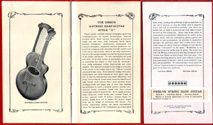 |
|
This could be one of the missing "B, C or
D" catalogs (which I believe), or a stand-alone brochure. According
to my records (possibly now-outdated), Dan Beimborn of the
Mandolin Archives originally dated this c.1904-05, Paul Fox
originally dated it c.1905-06, Rod McDonald now dates it
c.1905. As stated at left, I'm open to the
possibility that this could be the second, 1904
"catalog." It lists the 12-bass U and the 6-bass
R-1 (the latter with no image or specs). The U is the same
size and long scale as in 1903. While it shows only plain (ivoroid)
binding, it describes ivoroid in combination with something
that sounds like rope. |
|
Harp-Guitar Brochure
c.1906
(Harpguitars.net Members Only - password
required)
 |
|
This ultra-rare document (which may have also
been part of a full missing catalog), discovered in
2006, explains even more about the transitional instrument, with stringing
options and made-to-order instruments with 7 or 11 sub-basses and Walter
Boehm's newly suggested tunings (for 6, 7, 10 or 11 strings, the 12-bass
tuning having been abandoned).
It provides no specs (scale length would be
helpful). Thus, I don't think it's a portion from a
missinig catalog. It could be the "harp guitar
treatise" mentioned in Catalog E (and thus a c,1907
document). Or it could even be a c.1905
document. (For that matter, catalog "E" at right
might also be c.1906, though admittedly would create quite a gap
before "F" appeared)
|
|
Catalog E
c.1907
 |
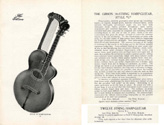 |
|
"E" lists only the 10-bass U and
the 6-bass R-1 (again, without image or specs).
The pictured Style U looks identical to that in the brochure at
left, and now has a 25-¾" scale.
|
|
|
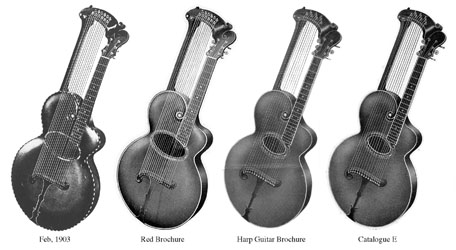
|
Let's re-cap the four currently known scroll-bridge
Style U's as shown and described in the catalogs: Note
the original huge, wide
soundhole, which was reduced during the 1904-1905 period. The
second "Red Brochure" image shows this also and still has the
long (27-¼") scale, but now with geared tuners and plain binding. We have seen
(and will show) 12-bass specimens with the long scale with both large
and small soundholes (and later small soundhole R's and U's with rope!). The
third "Harp Guitar Brochure" image shows the change to the
small soundhole and also to 10 subs (11 being the other option, 12
specifically abandoned). The scale is not given The
fourth "catalog E" image seems identical to the former, with
the new scale given (25-¾"),
Strangely, I cannot seem to detect the scale length change (from
27-¼" to 25-¾") in the above line-up. |
|
The sloped connection of the back/side (originally
carved from a single block) to the neck of the last three specimens
would seem to be a fantasy of the engraver's (were they starting with
the previous year's image and only altering certain features?) –
no
actual specimens have been seen (though, maddeningly, an R with a small
soundhole and this back/side/neck configuration has). Similarly,
as far as I know, no specimens with the fancy fingerboard curlicue
extension have ever been seen. George
Gruhn pointed out long ago how the catalogs always stated "maple
back and sides," yet none were apparently ever built.
Instead, the early models were typically walnut (occasionally mahogany)
and the later ones birch. There are numerous
other catalog discrepancies, and scores of actual known instruments with
additional combinations of features, many mixed and matched from early
and later catalog specs Eventually, we will be creating next a
full archive of these many typical variants and custom configurations. |
Catalog F
late 1908/early 1909
 |
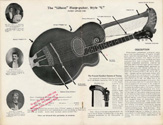 |
|
The new style U (already
announced in Cadenza, July, 1908 [see Ads])
makes its catalog debut (plus
see Patent below). My dating above comes from Cadenza
and Crescendo magazines; both announced receiving this
catalog in their January, 1909 issues. Note "Patent
Applied For" at top of page, which also confirms the period
(patent filed Nov 9, 1908).
The soundboard of these earliest floating bridge
U's was "ebonized unless otherwise ordered" (and
indeed, nearly all from the first few years are blacktops).
Note also that there is again a separate
"harp guitar treatise" offered (same as c.1906 or ?). |
|
Catalog G
c. October, 1910
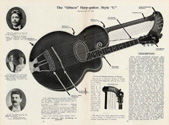 |
|
The new patent notice appears on the top of the
page (the patent having been granted in July).
|
|
Catalog H
c. 1912
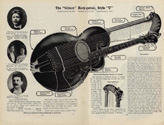 |
|
Slightly different graphics, otherwise identical
to G |
|
Catalog I
c. 1914-1915
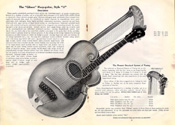 |
|
Catalog I now switches to red sunburst as
standard (ebonized or golden orange finish by special order). |
|
Catalogs
J (1917)
K (1918-1919)
L (c.1920)
M (c.1921)
These 4 catalogs show the same U engraving as
Catalog I, with nearly identical text (they drop the soundboard
finish
options). They continue (for awhile) to offer the
free harp guitar treatise, and amazingly, even up to c.1921 include "Always
state whether gut or wire strings are wanted" (see the Soundboard
article below).
|
|

|
This partial PDF of J includes
several intriguing pages on harp guitar details, including spare
parts, string options and the hilarious 2-page article "A
Little Harp Guitar Talk".
|
Catalog N
c. 1923
|
Catalog O
c. 1924-1925
|
Catalog P
(c. 1926)
Duplicate of Catalog O |
Catalog Q
c. 1928
|
Catalog R
c. 1929
Duplicate of Catalog Q |
Catalog
"Blue Cover"
c. 1930-1931
|
Catalog U
c. 1932
|
Catalog W
c. 1934
|
Catalog X
c. 1936
|
Catalog Y
c. 1937
Duplicate of Catalog X
This was the harp guitar's last appearance. |
Instructional
Material
|
The
"Gibson" New Model Harp-Guitar
This fascinating article is from The Sounding Board
- Gibson's own publication distributed to its sales force as a marketing
aid. These were published throughout the 1910s and into the 1920s.
This particular issue is Vol. 3 # 3, from 1914. That means the article
is referring to the floating
tailpiece "jazz" bridge Style U. It offers the best glimpse into
Gibson's intentions for their harp guitar. Note the mention that the tops
(even though arched and quite thick) were specifically built for gut
strings, not steel. Not only that, but they recommended moving all strings
over by a string (use a B for the E, etc.!) - in other words, increasing
the standard gut tension considerably. Of course, the advantage of the sub-basses is the main
focus of the article, and it includes specific examples of chord structure
possible on the Gibson harp guitar.
Article collected by John
Stropes, Xerox shared by Frank Doucette. |
The Modern
Harp-Guitar: Tuning the Sub-Basses
by Walter Boehm
This article is from The Cadenza, August, 1910. In
it, Walter Boehm discusses the reasoning behind the tuning for Gibson's
10-sub-bass harp guitar. It is believed that Boehm proposed this tuning to
Gibson, which they adopted by about 1906.
Note: This is a single-issue Cadenza article only. The
caption at the end of the article ("To be continued in the September
issue") is a typo!
Cadenza copy provided by Tom Noe. |
|
Music |
History |
Patent |
|
Book of Solos for
the Harp Guitar
1918 music folio by J. A. Witter
(Harpguitars.net Members Only -
password required)
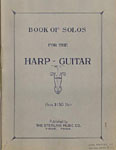
Likely the only historical publication of its time.
12
arrangements for the Gibson harp guitar that provide an example of the
repertoire of one of the few dedicated harp guitar soloists. |
Harp Guitar Arrangements by Walter Boehm
from The Cadenza |
The Gibson Story
by Julius Bellson
(Harpguitars.net Members Only -
password required)
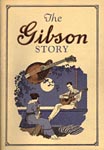
A portion of the groundbreaking 1973 booklet by
the late Gibson historian. |
Gibson's Harp Guitar Patent
Filed Nov 9, 1908
Granted July 19th, 1910

The classic Style U, designed by Gibson engineer
George D. Laurian. |
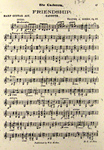 |
 |
|
Perhaps the foremost Gibson harp guitar soloist was Walter Boehm, who
helped Gibson create their eventual tuning system. The first piece
is his composition for mandolin and harp guitar from April, 1907, the
second, an arrangement from August, 1907 |
Strings
By late 1908 (catalog "F") the new 10-string tuning was already referred to as the ""universal or Standard System."
They credit Boehm, always including a comment like "Many of the above suggestions in tuning we owe to Walter Boehm,
one of the most competent authorities (or
respected Harp-guitarists) of America."
Catalogs F through M include "Always state whether gut or wire
strings are wanted." However, they go further in the back of the
catalogs, (the following example from 1917's J) offering
six options of strings for the neck strings (however, note that
gut was intended, per the Sounding Board article above). The sub-bass "Contra-bass strings" were available
(always) only in silver (presumably silver-plated copper) or copper, wound on
silk over a wire core. The two different colored metals for the wrap were not
chosen for tonal differences, but to "color-code" the strings for a visual guide, just as in
a harp (using copper for every third string –
clever!).
| 6-string neck |
| Option 1 |
silvered wire
(E,B,G), with option of silver spun on
silver (B,G) |
The
descriptions at left are directly from the 1917 Gibson catalog J.
Unfortunately, the grammar and verbiage is pretty arbitrary and we
are not always sure exactly what components make up each type of
string. For example, this one...option of "silver spun
on silver" - a skinny silver-wound silver B and G string? |
| Option 2 |
silvered
compound, spun on silk & silvered wire (E,B,G) |
What
is the "compound"? Does Gibson mean a compound alloy
of silver and another metal as the outer wrap - wound over
silk with a silver wire core? Or does "silvered
compound" refer to the fact that the string is a
"compound string" of silver and silk? In what order? Can
a high E string be wound in three or even two layers? |
| Option 3 |
copper
(E,B), with option of copper spun on
copper (B) |
Like
Option 1, a wound B string all in copper? |
| Option 4 |
silk (E),
gut (B) |
Is
the "silk" E silk spun on silk? |
| Option 5 |
silvered spun silk (E,B,G) |
No idea what
this refers to! |
| Option 6 |
compound strings (copper
spun on silk with wire center) |
This one
actually sounds normal. |
| Sub-bass ("Contra-bass strings") |
| G# |
silver wound |
Though
"silver" or "copper" wrap is stated, this
presumably means "silver-plated copper" as is standard
today.
The
two different wraps are wound on "silk with wire center"
(silk and steel).
|
| G |
silver wound |
| F# |
copper wound |
| F |
silver wound |
| D# |
silver wound |
| D |
copper wound |
| C# |
silver wound |
| C |
silver wound |
| B |
copper wound |
| A# |
silver wound |
| Additional
two strings for 12-sub-bass model. |
| A |
silver wound |
|
| G# |
copper wound |
|
| Note
that for the "old 12-bass model" the original tuning of
Eb chromatically down to E (an octave below the neck's E string)
as given in the 1903 catalog is no longer specified. Instead, they
simply use the same tuning as the standard 10-bass model for the
first ten strings (still no E), adding a low A and G#. It may be
that this tuning and stringing is intended for later
standard-scale scroll-bridge instruments that were modified for 12
basses instead of the now-standard 10 - as opposed to the 1903
long-scale original 12-bass instruments.
The tuning for the 6 sub-bass version (from the 1903 catalog) is
given as "usually D descending to F. Some players vary this tuning
for flat keys." Therefore, the nominal tuning would be
(low-to-high): F (an octave below the 1st fret on the E string), G,
A, B, C, D. No options are listed for the original
transitional 9-bass version. A full chart of all Gibson harp
guitar tunings is included in the Harpguitars.net
Tunings page. |
|
Iconography
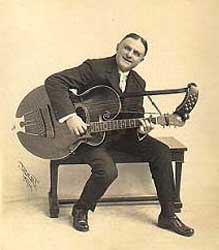
The Gibson harp guitars seem to have been the most
photographed version of all time.
There are hundreds of images out there,
of which we've just touched the surface. Please send yours in!
<
Back to Gibson Table of Contents
Gibson
section
by Benoît
Meulle-Stef with the help of:
- Gregg Miner for
editing, photos, formatting, additional research and information, appendix
- George
Gruhn for original
catalog material and help
- Dan Beimborn for catalog material and consultation
- Frank Nordberg for
catalog materials
- Rod McDonald and Paul
Fox for catalog material and consultation
- Many other owners and
sellers of Gibson harp guitars (credited in captions)
|

